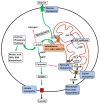Aiding Cancer's "Sweet Tooth": Role of Hexokinases in Metabolic Reprogramming
- PMID: 37109475
- PMCID: PMC10141071
- DOI: 10.3390/life13040946
Aiding Cancer's "Sweet Tooth": Role of Hexokinases in Metabolic Reprogramming
Abstract
Hexokinases (HKs) convert hexose sugars to hexose-6-phosphate, thus trapping them inside cells to meet the synthetic and energetic demands. HKs participate in various standard and altered physiological processes, including cancer, primarily through the reprogramming of cellular metabolism. Four canonical HKs have been identified with different expression patterns across tissues. HKs 1-3 play a role in glucose utilization, whereas HK 4 (glucokinase, GCK) also acts as a glucose sensor. Recently, a novel fifth HK, hexokinase domain containing 1 (HKDC1), has been identified, which plays a role in whole-body glucose utilization and insulin sensitivity. Beyond the metabolic functions, HKDC1 is differentially expressed in many forms of human cancer. This review focuses on the role of HKs, particularly HKDC1, in metabolic reprogramming and cancer progression.
Keywords: HKDC1; cancer metabolism; glucose metabolism; hexokinases; metabolic reprogramming.
Conflict of interest statement
The authors declare no conflict of interest.
Figures



References
-
- Sebastian S., Hoebee B., Hande M., Kenkare U., Natarajan A. Assignment of hexokinase types 1, 2, 3 (Hk1, 2, 3) and glucokinase (Gck) to rat chromosome band 20q11, 4q34, 17q12 and 14q21 respectively, by in situ hybridization. Cytogenet. Cell Genet. 1997;77:266–267. doi: 10.1159/000134593. - DOI - PubMed
Publication types
Grants and funding
LinkOut - more resources
Full Text Sources
Miscellaneous

